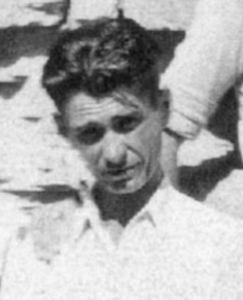
Biography
Thomas Michael Savage was perhaps Grant Wood's ideal of a regionalist painter. He was born in Fort Dodge, IA and studied at the Layton Art School in Milwaukee, WI. He worked full-time as a farmer before joining Wood's Stone City Art Colony in 1932. Wood was directing a Public Works of Art Project in Iowa City, and Savage joined a group of artists to work on murals for the Parks Library at Iowa State University in 1934. Wood designed the overall project and divided up tasks among the artists assisting him. Savage painted the people in the various panels of the work.
Some of the artists who had worked with Wood on this project were unhappy when funding for the PWAP dried up. They noticed that Wood still had his professorship and was still getting commissions for his work, while they were without income. The group, which included Savage, protested having Wood in a directorship for the federal art programs and formed an artists' union, the Cooperative Mural Painters Group (CMP). Four members of the CMP were able to gain a commission for a set of murals in Cedar Rapids, which they executed as a joint collaborative effort - in conscious contrast to Wood's top-down management approach.
Over time Savage received three commissions for Post Office murals - one in Jefferson, IA (1938), a second in New Hampton, IA (1939), and a third in Eupora, MS (1945). After the war Savage went to work as a commercial artist for Mid-Continent Bottlers, retiring from that job in 1974. He moved back to Fort Dodge in 1979, where he served as President of the local Federation of Arts and exhibited in competitions for the Fort Dodge Art Guild.
Savage died in Fort Dodge in 1987 and was honored with an exhibit “Tom Savage: A Regionalist Recognized,” which opened at the Blanden Art Museum in Fort Dodge in 2002.

Critical Analysis
While Savage broke with Wood over Wood's management style, he didn't move far from Wood in his style of painting. Savage's Post Office murals are all solid examples of the American Scene. While this approach to art prides itself of down-to-earth realism, there are some limitations to this ideal. Not only does the hay in Wood's Parks Library murals look like it was carefully combed; the hard-workers farmers and laborers in these paintings all have perfectly uncreased clothing. And, in Savage's "Butchering in Iowa" painting, critics noted that the whole process was depicted as being remarkably bloodless. This painting was one of Savage's most famous. It won first place in the Iowa Art Salon at the Iowa state Fair in 1934. From there it went to the office of the Secretary of Agriculture in Washington, after which it was selected for display in the White House. It now resides back in Fort Dodge in the collection of the Blanden Memorial Art Museum.
Murals
- Jefferson, Iowa - Post Office: The New Calf
- New Hampton, Iowa - Post Office: Breaking the Colt
- Eupora, Mississippi - Post Office: Cotton Farm
References
- Other Arts Follow - Engineering Panel (Iowa State University Library).
- Breanne Robertson, Politics in Paint: The Creation, Destruction, and Restoration of the Cedar Rapids Federal Courthouse Mural, The Annals of Iowa Volume 74, Number 3 (Summer 2015) (2015).
- Charlene Gustafson, Savage: Hope gleaned from the land, Des Moines Register October 20 (1987).
- Thomas Savage (When Tillage Begins: The Stone City Art Colony and School).
- Wood, Grant D. (Iowa State University Biographical Dictionary). By Kristy Raine.